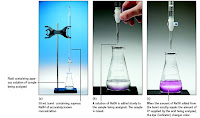
 An acid base evaluation of a solution is a method that allows us to know how much acid or basic is a solution. First of all, it's needed to have a known and trustworthy acid or basic solution, because it's needed to know its molarity.
An acid base evaluation of a solution is a method that allows us to know how much acid or basic is a solution. First of all, it's needed to have a known and trustworthy acid or basic solution, because it's needed to know its molarity. The acid base titration procedure starts placing the solution we want to study in an erlenmeyer flask. The next step is adding a pH indicator to the solution. A pH indicator is a substance that changes his color depending on the pH of its surroundings. Then, when this is prepared, we start working with the other needed solution, the basic solution. We spill it into a flask and we measure its volume. Then, with a dropper we add this solution to the one we want to study. When the color of all the solution we're studying starts to change, we start adding the basic solution more slowly and carefully, until the color gets fixed. In that moment, we measure how much basic solution we've spent, so we'll be able to calculate how many -OH molecules the starting solution has needed to get to the right pH for the indicator to change of color.
From here, knowing that every -OH molecule neutralizes an acid termination (it's needed to know which acid contains the starting solution) it's possible to calculate how many acid terminations were there in the starting solution. With this information, we just have to apply an easy calculation to find out the molarity of the starting solution that we wanted to study.

No comments:
Post a Comment